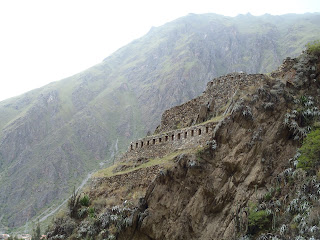A month-old alpaca on the left and 3-week-old llama on the right. They might look cute and fuzzy in this photo, but the multiple tender, juicy alpaca steaks I ate were definitely one of the highlights of my trip.
The ruins of the old Incan fortress and temple at Ollantaytambo.
Although various, wide-ranging theories exist, the exact meaning of these six stones, which are the centerpiece of the Ollantaytambo ruins, is still unknown.
Rainbow!
The Urubamba River, which runs through the entire Sacred Valley all the way to Macchu Pichu.
This is an archeological site known as Moray. It served as an agricultural research and investigation station for the Incans. They would plant different crops on different terraces, and then able to control the altitude, shade, and water (through their highly advanced irrigation systems), could conclude the optimum conditions and locations to plant all the different crops they had domesticated.
Not only had the Incans mastered terraced agriculture, they also were brilliant enough to include stairs in their terrace designs. After my nearly two years of agricultural work in El Salvador, what amazes me most is that the Incan people were easily more technologically-advanced farmers 600 years ago than the average Salvadoran farmer is today.
These are photos from a location known as Salinas, which has been in operation since the time of the Incas. They channeled the water of a spring, which emerges with salinity levels nearly equal to the Dead Sea (37%-40%), into thousands of individual pools, where after allowing for 3 months of evaporation, they are left with pounds of easily harvested salt. Today, much like hundreds of years ago during the Incan era, the nearby community then trades the harvested salt for the corn, quinoa, or potatoes produced in other areas.
These are the ruins of Pisac, located above a curve in the Urubamba river near the beginning of the Sacred Valley. Much like Macchu Pichu or Ollantaytambo (pictures above), the ruins include agricultural areas, fortressed military areas, and religious areas.






















Amazing Max, thanks. Looking forward to seeing more. dad
ReplyDeleteHello
ReplyDeleteI like your blog is very interesting, you have very good information about the Sacred Valley
I would like to visit the Sacred Valley, an agency know where they have hotels, tours, learn Spanish XD
Hello, I really liked your blog, responding to pol at the following website http://www.studyspanishsacredvalley.com/ there is much information about travel to cusco, hotels, tours, study Spanish language, I hope you find it useful
ReplyDelete